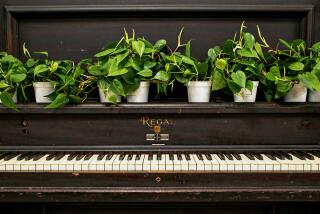Music Students Sharpen Their Ears With Unnoticed Thunks, Whooshes and Sighs
- Share via
PITTSBURGH — The sighs of students failing a test. The whoosh of swimmers under water. The drone of fluorescent lights. The “thunk” of a soft-drink machine dispensing a can.
Everyday sounds usually go unnoticed, but a Carnegie-Mellon University music professor is using them to help her students develop the ear sensitivity crucial to musicians.
Associate Prof. Marilyn Taft Thomas asked the 44 freshmen in her “Awareness of Sound” classes to compile “sound diaries.” The students were told to take note of striking sounds and describe them in a notebook.
Thomas was startled at the results. She not only had collections of sounds but snapshots of the lives of freshmen.
“Have you ever heard people failing a test?” wrote Melinda Klump, 18, of Saginaw, Mich. “It’s really amazing . . . all over the room are these sighs of exasperation and resignation. . . . It’s a very frustrating sound to hear, even if you think you’re making passing noises.”
Paul Lu, 19, of Allentown, visited a refinery and reported: “Very loud. Steam hissing, control signals beeping, dump truck, windy, messy. Hydraulic pump. Feet on metal stairs. Do I really want to be a chemical engineer?”
“The objective of the assignment was to develop the students’ ability to listen more acutely and more critically to everyday sounds, as well as to musical performances,” Thomas says. “But it did much more than that. It captured a very important transition in the lives of a group of young people.”
Serious students of music develop hearing so sensitive that they can recognize individual notes in recordings of musical pieces, Thomas says.
“I was trying to find new ways to actually open them to sound,” she says. “The diaries seemed like at least something that would cause them to focus on what they were listening to.”
Improved listening skills also can be important in other areas of life, she says. While teaching a Pittsburgh anti-poverty program in the 1960s, Thomas used music to improve ear sensitivity in preschoolers.
“What we had to do first was open their ears,” she says. “Kids who lived in very crowded environments had learned to close out sound to the point that their biggest problem when they started school was not listening and not knowing how to listen.
“They had made a physical adjustment to survive. In a very crowded, noisy environment, it’s the only way you can cope.”
Thomas says she knew that her experiment was working when her Carnegie-Mellon students became bored with “the same obvious sounds every day” and began to describe more subtle ones in greater and greater detail.
After walking through a university building, Klump wrote: “The Coke machine in Mudge Hall is stubborn--you put your money in, and it makes this huge self-abusing collage of clanks before it gives you a Coke. As if it hurts to give one up.”
After missing sleep for several nights to study, she wrote: “I haven’t slept for four days. Everything sounds really strange. . . . All the sounds are like I’m not really here. . . . I’m in a bubble.”
In another diary, a freshman from rural Massachusetts marveled at how different the cacophony of city sounds are from peaceful country sounds. After not hearing from her little brother for a month, she also rejoiced over the sound of his voice over the telephone.
“Under water everything is magnified and distorted,” wrote Susan Shimel, 19, of Seneca, S.C. “Movement from other swimmers. Air exhaled and bubbling to the surface to escape.”
More to Read
The biggest entertainment stories
Get our big stories about Hollywood, film, television, music, arts, culture and more right in your inbox as soon as they publish.
You may occasionally receive promotional content from the Los Angeles Times.










